Tecophilaea facts for kids
Quick facts for kids Tecophilaea |
|
|---|---|
 |
|
| Scientific classification |
|
| Kingdom: | Plantae |
| Clade: | Tracheophytes |
| Clade: | Angiosperms |
| Clade: | Monocots |
| Order: | Asparagales |
| Family: | Tecophilaeaceae |
| Genus: | Tecophilaea Bertero ex Colla |
| Synonyms | |
|
|
Tecophilaea is a small group of beautiful flowering plants. It belongs to a plant family called Tecophilaeaceae. There are only two known species (types) of plants in the Tecophilaea group. One of these, the Chilean Blue Crocus, is very special but also in danger.
Contents
What is Tecophilaea?
Tecophilaea plants are known for their pretty flowers. They are often found in specific parts of the world. Like all plants, they play an important role in their natural homes.
The Chilean Blue Crocus
The Chilean Blue Crocus (its scientific name is Tecophilaea cyanocroccus) is one of the two species in this group. It gets its name because it looks a bit like a crocus flower and has lovely blue petals. This plant is native to Chile, a country in South America.
Why is it Special?
The Chilean Blue Crocus is special because it is quite rare. It grows in specific areas and needs certain conditions to thrive. Its beautiful blue color makes it stand out.
Why is it in Danger?
Sadly, the Chilean Blue Crocus is considered "at risk." This means its numbers are getting very low in the wild. Organizations like the IUCN keep track of plants and animals that are in danger. They put them on a list called the IUCN Red List. Plants can become endangered for many reasons, like their natural homes being destroyed or changes in the climate.
Protecting Rare Plants
It's important to protect plants like the Chilean Blue Crocus. When a plant species disappears, it can affect other living things that depend on it. Scientists and conservationists work hard to understand these plants and find ways to help them survive. This might involve protecting their habitats or growing them in special gardens to help their numbers grow.
See also
 In Spanish: Tecophilaea para niños
In Spanish: Tecophilaea para niños

